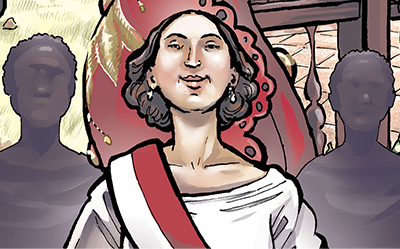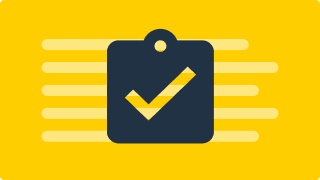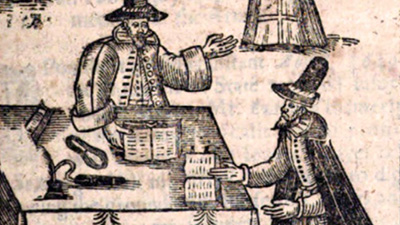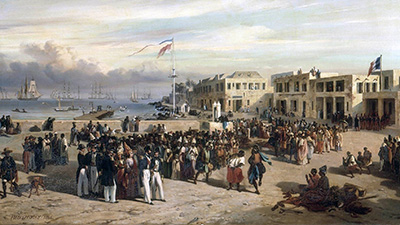The Atlantic Revolutions
Teacher Resources
Driving Question: How was the period from 1750 to 1825 an Age of Revolutions?
Revolutions are major transformations in how people live, think, govern, connect, or produce. Such dramatic changes are often violent and always disruptive, so why would a society want a revolution? The answer depends on the circumstances of the society—the revolutions that took place across the Atlantic world differed in their origins. In one instance, an enslaved population overthrew its colonizers, turning the world upside down.
Learning Objectives:
- Analyze the causes and consequences of the Atlantic revolutions.
- Use causation to evaluate and analyze the revolutions of this era.
- Use a graphic biography to support, extend, or challenge the overarching narratives of this period.
Vocab Terms:
- autonomy
- citizen
- conservative
- constitution
- ideology
- liberal
- patriarchal
- popular sovereignty
- radical
- tax
Opener: Atlantic Revolutions
To teach this lesson step, refer to page 3 of the Lesson 4.3 Teaching Guide.
Our Openers and Closers Guide will provide more information about these short, but important activities at the beginning and end of each lesson.
In this lesson, you’ll learn about an age of revolutions that swept across the world. This activity will get you thinking about the impacts of this turbulent time.
Revolutions Around the World
To teach this lesson step, refer to page 3 of the Lesson 4.3 Teaching Guide.
Ready to cook up a revolution? See Recipe for a Revolution Materials from in the OER Project Community Forum.
Beginning in the late eighteenth century, a revolutionary wave swept the Atlantic Ocean, overturning old governments and ushering in new ideas about freedom.
-
Guiding Questions
-
Before you read
Preview the questions below, and then skim the article. Be sure to look at the section headings and any images.
While you read
Look for answers to these questions:
- How did the Seven Years’ War help lead both the American and French Revolutions?
- What were the results of the American Revolution in terms of achieving independence and creating an egalitarian society?
- How did the French Revolution transform France?
- Why was the Haitian Revolution the most radical of them all?
- What fears led to internal divisions within the Latin American revolutions?
After you read
Respond to these questions: What sort of things can political revolutions change? Are there any limits on the changes these sorts of revolutions can bring? Why or why not?
-
Guiding Questions
-
Before you watch
Preview the questions below, and then review the transcript.
While you watch
Look for answers to these questions:
- What were the main social classes in Saint-Domingue, and why was this social pyramid unstable?
- What was life like for an enslaved person in Saint-Domingue?
- What was the goal of the revolutionaries in the revolution’s early days?
- Who was Toussaint Louverture, and why did he fight first with the Spanish and then with the French?
- How did enslaved people learn about revolutionary ideas?
After you watch
Respond to this question: This video makes the argument that the Haitian Revolution was the most radical of the Atlantic revolutions. Do you agree?
The Haitian Revolution defeated the French Empire, abolished slavery, and shook the foundations of the Atlantic slave economy. But the struggle didn’t end there.
Key Ideas
Women and Revolution
To teach this lesson step, refer to page 6 of the Lesson 4.3 Teaching Guide.
Check out this teacher-created blog post, Revolutionary Women: Little Tweaks Make a Perfect Fit, for another take on teaching this activity.
Though revolutionary narratives are often centered on founding fathers, plenty of women played central roles in defining the Age of Revolutions.
-
Guiding Questions
-
Before you read
Preview the questions below, and then skim the comic, paying attention to things like prominent colors, shapes, and types of text and fonts. How do you know where to start and in which direction to read? What’s in the gutters (the space between panels)? Who or what is the focus of the comic?
While you read
- How did Sáenz’s father try to teach her to be obedient, and what was the result?
- Who were Manuela Sáenz’s companions, and why don’t we know a lot about them?
- How did Manuela Sáenz, Jonotas, and Natan serve Simón Bolívar and the revolutionaries?
- How does the artist show Sáenz’s attempt to break out of confinement using art?
- How does the artist portray Jonotas and Natan? Why does she make this choice?
After you read
Respond to this question: How does this biography of Manuela Sáenz support, extend, or challenge what you have learned about social transformations and their limits during the long nineteenth century?
Closer: Atlantic Revolutions
To teach this lesson step, refer to page 7 of the Lesson 4.3 Teaching Guide.
Writing is at the core of what historians do. For help in supporting your developing historians with writing, take a look at the OER Project Writing Guide.
Writing: Political Revolutions
To teach this lesson step, refer to page 7 of the Lesson 4.3 Teaching Guide.
In this writing activity, you’ll use evidence from sources to support an argument that responds to the question: What were the most significant causes of political revolutions during the long nineteenth century?
Revolutionary Ideas in England
To teach this lesson step, refer to page 7 of the Lesson 4.3 Teaching Guide.
The roots of revolutionary thought extend further back than the Enlightenment. Extend this lesson by exploring the political changes in England that started 600 years before the Age of Revolutions.
-
Guiding Questions
-
Before you read
Preview the questions below, and then skim the article. Be sure to look at the section headings and any images.
While you read
Look for answers to these questions:
- What rights did the Magna Carta guarantee to the barons, and how were these principles reflected in the United States Constitution and Bill of Rights?
- When did the English Civil War take place, and what were its causes and outcomes?
- How did the English Civil War influence the American War of Independence?
- Who were the key figures in the Glorious Revolution of 1688, and what key provisions followed in the English Bill of Rights?
- Who were the influential British philosophers advocating for democracy during the American Revolution?
After you read
Respond to this question: Do you think the American Revolution was more influenced by events in Britain, or were unique factors within the American colonies more significant?
Expanding the Age of Revolutions
To teach this lesson step, refer to page 9 of the Lesson 4.3 Teaching Guide.
Revolutionary movements erupted in many places beyond America and France. Use this article and video to evaluate whether we should expand the narrative of the Atlantic revolutions.
-
Guiding Questions
-
Before you read
Preview the questions below, and then skim the article. Be sure to look at the section headings and any images.
While you read
Look for answers to these questions:
- When did ‘Uthman dan Fodio’s revolution take place in northern Nigeria? What other revolutions in the Atlantic world were taking place right around this time?
- What economic factors led to revolutions in West Africa?
- What was the ideology or unifying force for revolution in West Africa?
- What revolutionary state did ‘Uthman dan Fodio create? How revolutionary was this state?
After you read
Respond to this question: Would you include these West African revolutions as part of the Atlantic revolutions?
-
Guiding Questions
-
Before you watch
Preview the questions below, and then review the transcript.
While you watch
Look for answers to these questions:
- Why did the Spanish decide to invade New Mexico and what were some of the immediate consequences of the decision?
- What are some examples of how Pueblo people experienced colonization?
- What are some of the ways that Pueblo people resisted Spanish colonization before 1680?
- What big event sparked the Pueblo Revolt?
- How did the Pueblos coordinate the revolt? Was it successful?
After you watch
Respond to this question: Do you agree with the statement that the Pueblo Revolt of 1680 was the first and most successful revolt against European colonialism?









